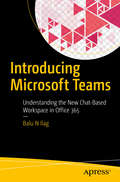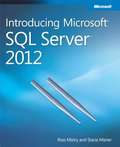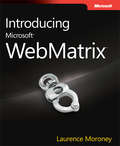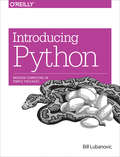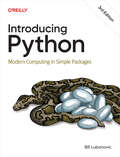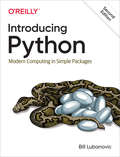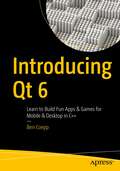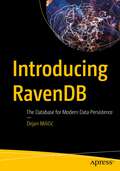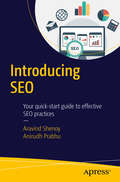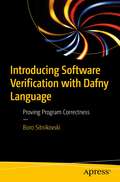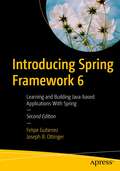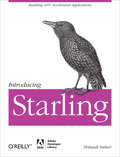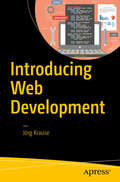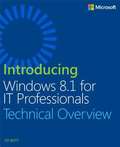- Table View
- List View
Introducing Microsoft Teams: Understanding the New Chat-Based Workspace in Office 365
by Balu N IlagGain industry best practices from planning to implementing Microsoft Teams and learn how to enable, configure, and integrate user provisioning, management, and monitoring. This book also covers troubleshooting Teams with step-by-step instructions and examples. Introducing Microsoft Teams gives you the comprehensive coverage you need to creatively utilize Microsoft Teams services.The author starts by giving an introduction to Microsoft Teams and its architecture followed by optimizing the Teams experience where he describes how organizations can prepare for Teams and enhance existing services. He further shows you how to manage and control the Microsoft Teams experience along with its capabilities and enhancements. You’ll learn how to migrate from Skype for Business to Microsoft Teams with a step-by-step tutorial. Finally, you’ll get to grips with Teams troubleshooting and best practices.This book has detailed coverage that helps you exploit every capability Microsoft Teams has to offer. It provides the answers you need and the insight that will make your journey from Skype for Business to Teams easier. What You Will Learn Enable guest access in Teams Provision and manage users in Teams Administrate Teams and channelsOptimize the Teams experienceEnable and configure Microsoft TeamsPrepare your network for Microsoft Teams and Office 365 services Migrate from Skype for Business to Microsoft TeamsWho This Book Is ForUnified communication administrators and IT support engineers who are currently supporting an existing unified communication platform such as Skype for Business (Lync). It would also help support engineers, new administrators, and consultant to start their journey with Teams.
Introducing Microsoft® SQL Server® 2012
by Stacia Misner Ross MistryIntroducing Microsoft® SQL Server® 2012 explores the exciting enhancements and new capabilities engineered into SQL Server, ranging from improvements in operation to those in reporting and management. This book is for anyone who has an interest in SQL Server 2012 and wants to understand its capabilities, including database administrators, application developers, and technical decision makers.
Introducing Microsoft® Silverlight™ 2, Second Edition
by Laurence MoroneyGet a head start with Silverlight 2--the cross-platform, cross-browser plug-in for rich interactive applications and the next-generation user experience. Featuring advance insights from inside the Microsoft Silverlight team, this book delivers the practical, approachable guidance and code to inspire your next solutions, and offers pointers to C# and XAML code samples on the Web. Discover how to: Create your first simple sites and browser-hosted applications Use XAML to render, scale, and animate graphics on-screen Exploit Microsoft .NET runtime and Visual Studio language support Explore the full suite of controls--build and extend your own Experiment with media, ink, and Deep Zoom capabilities Create connected applications Put dynamic languages such as Ruby and Python to work Deliver skinned media content Manage Silverlight applications from ASP.NET-based servers
Introducing Microsoft® Silverlight™ 3
by Laurence MoroneyGet a running start with Silverlight 3--the cross-platform, cross-browser plug-in for rich interactive applications and cutting-edge media experiences. Featuring advance insights from inside the Microsoft Silverlight team--this book provides practical, grounded advice, rich examples, and ready code to help inspire your next solutions. Discover how to: Create your first simple sites Build applications that run out of the browser Use XAML to render, scale, and animate graphics on-screen Work with Silverlight Tools for Visual Studio Explore core and advanced controls--and build your own Exploit new graphics support--3-D effects, H.264 video, GPU acceleration Experiment with media, ink, DeepZoom, and Photosynth * Access data services to build connected applications Dynamically add content using Ruby and Python Manage Silverlight applications from ASP.NET-based servers Learn how to deliver DRM-protected video content
Introducing Microsoft® WebMatrix™
by Laurence MoroneyYour first look at the easy-to-use tools for building your own data-driven website Get a running start with Microsoft WebMatrix--the free, downloadable web development solution featuring all the tools you need for server-side programming. This practical book introduces the templates, helper libraries, and other tools in WebMatrix for building and customizing a data-driven site--including techniques for adding video, email, web forms, and other features. Learn how easy it can be to create a dynamic web presence for your small business or organization with WebMatrix. Get early, expert insights to help you: Write server-side code with either Microsoft ASP.NET or PHP Build a database application that lets you create, retrieve, update, and delete records Deliver video on your site with Microsoft Silverlight® or HTML5 Add simple email functions--or build your own email application Accept payments on your site with PayPal Capture user input by building web forms and controls Set up an application to promote your site through social networking Create a site with WordPress, and discover how to use other PHP-based web applications Get code samples on the web. For system requirements, see the Introduction.
Introducing Python
by Bill LubanovicEasy to understand and fun to read, Introducing Python is ideal for beginning programmers as well as those new to the language. Author Bill Lubanovic takes you from the basics to more involved and varied topics, mixing tutorials with cookbook-style code recipes to explain concepts in Python 3. End-of-chapter exercises help you practice what you've learned.You'll gain a strong foundation in the language, including best practices for testing, debugging, code reuse, and other development tips. This book also shows you how to use Python for applications in business, science, and the arts, using various Python tools and open source packages.Learn simple data types, and basic math and text operationsUse data-wrangling techniques with Python's built-in data structuresExplore Python code structure, including the use of functionsWrite large programs in Python, with modules and packagesDive into objects, classes, and other object-oriented featuresExamine storage from flat files to relational databases and NoSQLUse Python to build web clients, servers, APIs, and servicesManage system tasks such as programs, processes, and threadsUnderstand the basics of concurrency and network programming
Introducing Python
by Bill LubanovicStuck in a coding conundrum? Whether you're an advanced beginner, an intermediate developer, or a curious newcomer, the complexities of coding can often feel like a labyrinth with no exit. With Python, however, you can start writing real code quickly—but where should you start? In this updated third edition, Bill Lubanovic acts as your personal guide to Python, offering a clear path through the intricacies and capabilities of this much-beloved coding language, including new chapters on AI models and performance enhancements. Easy to understand and enjoyable to read, this book not only teaches you the core concepts but also dives into practical applications that bridge the gap between learning and doing. By reading it, you will: Understand everything from basic data structures to advanced features Gain insights into using Python for files, networking, databases, and data science Learn testing, debugging, code reuse, and other essential development tips Explore how Python can be utilized in business, science, and the arts
Introducing Python: Modern Computing in Simple Packages
by Bill LubanovicEasy to understand and fun to read, this updated edition of Introducing Python is ideal for beginning programmers as well as those new to the language. Author Bill Lubanovic takes you from the basics to more involved and varied topics, mixing tutorials with cookbook-style code recipes to explain concepts in Python 3. End-of-chapter exercises help you practice what you’ve learned.You’ll gain a strong foundation in the language, including best practices for testing, debugging, code reuse, and other development tips. This book also shows you how to use Python for applications in business, science, and the arts, using various Python tools and open source packages.
Introducing Qt 6: Learn to Build Fun Apps & Games for Mobile & Desktop in C++
by Ben CoeppGet started quickly with Qt, the popular open source C++ framework for building C++-based applications and games. This book will have you building both fully functional desktop and mobile applications in no time, including some simple game applications. Introducing Qt 6 begins by guiding you in setting up your tools and environment, and then walks you through the first "baby steps" of Qt framework. Next, you'll learn the basics of how project and app structure are set up using Qt. Then, you’ll begin your first real hands-on projects using Qt, including a task and problem management application and two games. As you progress, you can enhance these apps and games using additional Qt components and features. The book then delves into advanced topics in Qt, learning above and beyond what the Qt docs can offer, including local storage, C++ integration, deployment to Windows and Android, custom components and how to work with them. Upon completing this book, you'll come away knowing how to build a C++ application from design to deployment, top to bottom. And, you'll have actual application and game examples that you can apply to your own work or hobby. What You Will Learn Learn to build your first applications and games using Qt 6 frameworkDesign, create, build and deploy your first Qt applications or games as finished productsExplore local storage integration in theory and practiceCover deployment on Windows and on AndroidIntegrate with C++ language to leverage additional functionalityDive into Custom Components and how to work with themExplore different project structures and more Who This Book Is For Software programmers, developers who are new to C++ or the Qt framework. Some prior programming experience though may be helpful.
Introducing RavenDB: The Database for Modern Data Persistence
by Dejan MiličićSimplify your first steps with the RavenDB NoSQL Document Database. This book takes a task-oriented approach by showing common problems, potential solutions, brief explanations of how those solutions work, and the mechanisms used. Based on real-world examples, the recipes in this book will show you how to solve common problems with Raven Query Language and will highlight reasons why RavenDB is a great choice for fast prototyping solutions that can sustain increasing amounts of data as your application grows. Introducing RavenDB includes code and query examples that address real-life challenges you’ll encounter when using RavenDB, helping you learn the basics of the Raven Query Language more quickly and efficiently. In many cases, you’ll be able to copy and paste the examples into your own code, making only minor modifications to suit your application. RavenDB supports many advanced features, such full-text search, graph queries, and timeseries; recipes in the latter portion of the book will help you understand those advanced features and how they might be applied to your own code and applications. After reading this book, you will be able to employ RavenDB’s powerful features in your own projects. What You Will Learn Set up and start working with RavenDBModel your objects for persistence in a NoSQL document databaseWrite basic and advanced queries in the Raven Query Language Index your data using map/reduce techniques Implement techniques leading to highly performant systems Efficiently aggregate data and query on those aggregations Who This Book Is For Developers accustomed to relational databases who are about to enter a world of NoSQL databases. The book is also for experienced programmers who have used other non-relational databases and want to learn RavenDB. It will also prove useful for developers who want to move away from using Object-Relational Modeling frameworks and start working with a persistence solution that can store object graphs directly.
Introducing ReScript: Functional Programming for Web Applications
by Danny YangThis book serves as a succinct guide on ReScript, a functional language for building web applications. Using examples of ReScript language features along with explanations of fundamental concepts in functional programming, this book will show web developers with a background in JavaScript how to effectively use ReScript to its full potential. In Introducing ReScript, you'll learn how to use features in ReScript that JavaScript lacks, such as type inference, null-safety, algebraic data types, pattern matching, and more. Along the way, you'll pick up functional programming concepts like immutability and higher-order functions. You'll also gain a sense of how ReScript works under the hood and how to leverage interoperability between ReScript and JavaScript. Whether you're a web developer interested in dabbling with functional programming or you just want to learn how to write safer and cleaner code for web applications, this book is a great way for you to get started with ReScript. What You Will LearnUse ReScript to write clean, safe, and elegant softwareUnderstand the features of ReScript that set it apart from JavaScript, such as type inference, null-safety, and algebraic data typesExplore functional programming concepts like immutabhigher-orderr order functions, and pattern matchingUse popular JavaScript libraries and frameworks in your ReScript code and integrate ReScript code into JavaScript codebases Who This Book Is For Web developers that want a strictly typed, safer alternative to JavaScript, as well as web developers interested in learning functional programming and leveraging the elegant and powerful functional features in ReScript.
Introducing Regular Expressions: JavaScript and TypeScript
by Jörg KrauseThis book is your easy-to-digest and concise guide to regular expressions in JavaScript, this book teaches you the very basics and can be used in the browser or on the server. Explore and understand how to use regular expressions in all JavaScript environments. Presented in four key concept sections, Introducing Regular Expressions shows how to create and use regular expressions to accelerate your JavaScript development.What You'll LearnWhat regular expressions are and why you should use them Use useful expressions (including examples)Reference features and functionsUse regular expressions in all JavaScript environmentsWho This Book Is For Developers of web applications who want to explore the capabilities of JavaScript based apps on both, client and server. It’s suitable for beginners that have a basic understanding of JavaScript already.
Introducing Regular Expressions: Unraveling Regular Expressions, Step-by-Step
by Michael FitzgeraldIf you’re a programmer new to regular expressions, this easy-to-follow guide is a great place to start. You’ll learn the fundamentals step-by-step with the help of numerous examples, discovering first-hand how to match, extract, and transform text by matching specific words, characters, and patterns.Regular expressions are an essential part of a programmer’s toolkit, available in various Unix utlilities as well as programming languages such as Perl, Java, JavaScript, and C#. When you’ve finished this book, you’ll be familiar with the most commonly used syntax in regular expressions, and you’ll understand how using them will save you considerable time.Discover what regular expressions are and how they workLearn many of the differences between regular expressions used with command-line tools and in various programming languagesApply simple methods for finding patterns in text, including digits, letters, Unicode characters, and string literalsLearn how to use zero-width assertions and lookaroundsWork with groups, backreferences, character classes, and quantifiersUse regular expressions to mark up plain text with HTML5
Introducing Robotic Process Automation to Your Organization: A Guide for Business Leaders
by Robert Fantina Andriy Storozhuk Kamal GoyalFor your robotic process automation (RPA) program to be successful, you need to follow a general framework and governance model. This book covers, in detail, what they should look like and how to adapt them to your organization.Introducing Robotic Process Automation to Your Organization is structured to enable you, a novice to RPA, to successfully implement an RPA program at your company. RPA is rapidly growing in use, but is only starting to be taught at a university level. Many mid-level managers will be tasked with introducing an RPA program at their organizations as senior management learns of its efficacy, but will be unfamiliar with how to do so. This book provides you with the skills and information you need to make an informed decision. For decades, there has been much discussion about the fast pace of technology, the rapidly changing technology environment, and the need for companies to be on the cutting edge to remain competitive or even relevant. In this ever-changing environment, there is a need to know what can be done in terms of current processes, here and now, that will increase efficiency, benefit customers, and improve profitability. One option is RPA.This book includes information to assist you in getting the required buy-in and identifying the first few processes for automation. A structure for identifying opportunities on an ongoing basis is detailed, along with concepts that must be considered for solution design and deployment. Throughout the book there are several "pause and consider" statements to help you think about how principles pertain to your organization. Additionally, there are tips included that offer short, concrete suggestions on how to help implement the particular step being discussed.What You Will LearnKnow the benefits of robotic process automation (RPA)Understand the limitations of RPAAsk the right questions to determine whether a process is a good candidate for automationObtain buy-in from skeptics at the senior and middle manager levels, and from line workersBe familiar with the structure required for successWho This Book is ForMiddle managers who have either identified the need for robotic process automation (RPA) in their organization or have been directed by senior management to explore the possibility of introducing RPA to their organization; managers at all levels who hear about RPA, either through conferences, professional associations, or industry publications, and want to know more; students of business and technology who wish to broaden their understanding of important current trends.
Introducing SEO
by Aravind Shenoy Anirudh PrabhuThis is your easy-to-digest brief introduction to SEO (search engine optimization) - an imperative methodology used to affect the visibility of websites using different strategies and techniques. Using this book, you'll understand techniques, practical implementations, and concepts to make you familiar with this technology. You will understand SEO basics, search engine methodology, ranking and Google tools. You will also cover keywords, link building, and the role of online marketing with social media. This book will jumpstart your knowledge with an easy-to-follow approach so you can come to grips with the latest version of the framework. A downloadable code bundle is also included for you to play with, and therefore understand, the subtle nuances of the latest version. What you'll learn How to incorporate effective SEO into your workflow How to use keywords, link building, and online social media marketing How to implement SEO-specific plans and strategies. Who this book is for This book is aimed at beginners who want a quick, no-nonsense introduction to SEO. No prior experience or knowledge of SEO is required to understand the concepts in this book.
Introducing SQL Server
by Mike McquillanIntroducing SQL Server is a fast and easy introduction to SQL Server and the world of relational databases. You'll learn how databases work and how to use the T-SQL language by practicing on one of the most widely-used and powerful database engines in the corporate world: Microsoft SQL Server. Do you quake at the sight of a SELECT statement? Start to shiver when people start talking about tables and rows? Fear not, Introducing SQL Server is here to rescue you. The book focuses on the knowledge and skills needed to begin your journey toward becoming a solid and competent SQL Server professional and database programmer. You'll learn the core concepts of SQL Server, from installing the software to executing and profiling queries. Introducing SQL Server is aimed at SQL Server newcomers as well as at those wanting to improve their database skills. You'll put a comprehensive database together as you work through the book. You will create tables and learn to use constraints; create reusable functions and stored procedures; and even learn how indexes work and what they bring in terms of increased performance. Introducing SQL Server shows you that databases don't need to be difficult. Teaches you how to build a SQL Server database from scratch Takes a tutorial-based approach, with each chapter building on the last Covers what you need to know for common SQL Server development tasks What you'll learn Install SQL Server and customize your system Build databases and table Become conversant with the T-SQL language Import data using text files and T-SQL Program in T-SQL, creating stored procedures and functions Administer SQL Server at a basic level, including query and index management Who this book is for Introducing SQL Server is for anybody who wants to learn how databases are put together in Microsoft SQL Server. It's especially helpful to database newcomers, software developers who want to improve their SQL Server knowledge, and those whose SQL knowledge has lapsed over time. Introducing SQL Server's unique tutorial-led approach makes it a great choice for those who enjoy learning by doing. It's also a great reference book to keep on your desk. Table of Contents Chapter 1: What is SQL Server? Chapter 2: Obtaining and Installing SQL Server Chapter 3: Database Basics Chapter 4: Tables Chapter 5: Putting Good Tables Together Chapter 6: Automating Deployment with SQLCMD Chapter 7: NULLs and Table Constraints Chapter 8: Inserts, Updates, and Deletes Chapter 9: Bulk Inserting Data Chapter 10: Creating Data Import Scripts Chapter 11: The SELECT Statement Chapter 12: Joining Tables Chapter 13: Views Chapter 14: Indexes Chapter 15: Transactions Chapter 16: Functions Chapter 17: Table-Valued Functions Chapter 18: Stored Procedures - Part 1 Chapter 19: Stored Procedures - Part 2 Chapter 20: Bits and Pieces Chapter 21: Appendix A: SQL Data Types Chapter 22: Appendix B: Glossary Chapter 23: Appendix C: Common SQL Server System Objects Chapter 24: Appendix D: Exercises
Introducing SQLite for Mobile Developers
by Jesse FeilerThis brief book is a basic introduction to SQLite for iOS and Android developers. The book includes a simple introduction to SQL, a discussion of when to use SQLite, and chapters devoted to using SQLite with the most likely programming languages: Java, PHP, Swift and Objective-C. It then goes through adding simple database functionality to an Android or iOS app and finally a chapter on managing the app's life cycle. What you'll learn What You Will Learn:The basics of SQLite The SQL you need to use SQLite effectively How to integrate database functionality into your mobile app. How to maintain the app Who this book is for This book is for Android or iOS developers who wish to use a lightweight but flexible database for their applications. It assumes mobile development experience but does not assume any database knowledge. Table of Contents 1. Getting Up to Speed with Databases and SQLite 2. Understanding What SQLite Is. . . 3. Working with the relationship model and SQLite 4. Using SQLite basics -- storing and retrieving data 5. Using SQLite features -- What you can do with SELECT statements 6. Using SQLite with PHP 7. Using SQLite with Java (Android) 8. Using SQLite with Swift (iOS/Mac) 9. Using SQLite with Objective-C (iOS/Mac) 10. Exploring the simple database (used in Chapters 10-12) 11. Using the simple database with a website (database example code included) 12. Adding the simple database to an Android app (using android. database. sqlite) 13. Adding the simple database to an iOS app (using Core Data) 14. Considering performance issues 15. Managing the SQLite life cyle
Introducing Software Verification with Dafny Language: Proving Program Correctness
by Boro SitnikovskiGet introduced to software verification and proving correctness using the Microsoft Research-backed programming language, Dafny. While some other books on this topic are quite mathematically rigorous, this book will use as little mathematical symbols and rigor as possible, and explain every concept using plain English. It's the perfect primer for software programmers and developers with C# and other programming language skills.Writing correct software can be hard, so you'll learn the concept of computation and software verification. Then, apply these concepts and techniques to confidently write bug-free code that is easy to understand. Source code will be available throughout the book and freely available via GitHub.After reading and using this book you'll be able write correct, big free software source code applicable no matter which platform and programming language you use. What You Will LearnDiscover the Microsoft Research-backed Dafny programming language Explore Hoare logic, imperative and functional programsWork with pre- and post-conditionsUse data types, pattern matching, and classesDive into verification examples for potential re-use for your own projectsWho This Book Is ForSoftware developers and programmers with at least prior, basic programming experience. No specific language needed. It is also for those with very basic mathematical experience (function, variables).
Introducing Spoken Dialogue Systems into Intelligent Environments
by Wolfgang Minker Tobias HeinrothIntroducing Spoken Dialogue Systems into Intelligent Environments outlines the formalisms of a novel knowledge-driven framework for spoken dialogue management and presents the implementation of a model-based Adaptive Spoken Dialogue Manager(ASDM) called OwlSpeak. The authors have identified three stakeholders that potentially influence the behavior of the ASDM: the user, the SDS, and a complex Intelligent Environment (IE) consisting of various devices, services, and task descriptions. The theoretical foundation of a working ontology-based spoken dialogue description framework, the prototype implementation of the ASDM, and the evaluation activities that are presented as part of this book contribute to the ongoing spoken dialogue research by establishing the fertile ground of model-based adaptive spoken dialogue management. This monograph is ideal for advanced undergraduate students, PhD students, and postdocs as well as academic and industrial researchers and developers in speech and multimodal interactive systems.
Introducing Spring Framework 6: Learning and Building Java-based Applications With Spring
by Joseph B. Ottinger Felipe GutierrezSpring Framework 6 remains - by far - the leading de-facto "out of the box" practical Java meta application development framework for building complex enterprise, cloud-native applications as well as web applications and microservices. Introducing Spring Framework 6 is your hands-on tutorial guide for learning the Spring Framework 6 from top to bottom, and allows you to build an example application along the way from the ground-up.As you learn the Spring Framework over the course of this book, you’llincrementally build your first Spring application piece-by-piece as you learn each module, project or component of the Spring Framework and its extensions and ecosystem. As you learn the various fundamentals, you'll then apply them immediately to your Spring application. This Spring application, My Documents, enables you to learn by doing. After reading this book, you will have the essentials you should need to start using the Spring Framework and building your own Java-based applications or microservices with it.What you'll learn:Get started with Spring Framework 6 by VMWare Tanzu and the Spring communityBuild your first My Documents application using Spring Framework and its extensionsTest your Spring applicationAdd persistence to your application using Spring Data JPA and moreShow your Spring application on the Web with Spring MVC and relatedUse REST APIs to enhance your application and add messaging with Kafka and AMQPIntegrate your Spring application with external systems using Spring Integration toolkitWho is this book for:This book is for those aspiring software developers and programmers who are new to Spring. Some prior programming experience recommended, preferably in Java.
Introducing Starling
by Thibault ImbertStarling is an ActionScript 3 2D framework developed on top of the Stage3D APIs (available on desktop in Flash Player 11 and Adobe AIR 3). Starling is mainly designed for game development, but could be used for many other use cases. Starling makes it possible to write fast GPU accelerated applications without having to touch the low-level Stage3D APIs.Most Flash developers want to be able to leverage GPU acceleration (through Stage3D) without the need to write such higher-level frameworks and dig into the low-level Stage3D APIs. Starling is completely designed after the Flash Player APIs and abstracts the complexity of Stage3D (Molehill) and allows easy and intuitive programming for everyone.Obviously Starling is for ActionScript 3 developers, especially those involved in 2D game development; of course you will need to have a basic understanding of ActionScript 3. By its design (lightweight, flexible and simple), Starling can be used also be used for other use cases like UI programming. That said, everything is designed to be as intuitive as possible, so any Java™ or .Net™ developer will get the hang of it quickly as well.
Introducing Vala Programming: A Language and Techniques to Boost Productivity
by Michael LauerGet an introduction into the Vala programming language and learn about its syntax, semantics, and idioms. Do you want to boost your productivity? Are you interested in a programming language that combines the efficiency of a scripting language with the performance of a compiled language? Did you always want to write GTK+ or GNOME programs, but hate C with a passion? Read this book and learn Vala!Introducing Vala Programming starts from Hello World and goes up to graphical user interfaces using GTK+, covering DBus interprocess communication, network programming, Linux specifics, and more. You’ll learn how to leverage external libraries and enhance Vala by writing bindings to new libraries.What You Will LearnDiscover the Vala programming language and how to use it to boost your productivityUse Vala syntax and semanticsWrite object-oriented code with ValaWork with DBusImplement networking with ValaIntegrate and use external libraries with bindings and libgusbWho This Book Is ForPeople with basic programming experience in any imperative programming language.
Introducing Web Development
by Jörg KrauseThis brief book is an easy-to-digest introduction to the key concepts of web development. Understand the concepts of the web and how they apply to static and dynamic websites. See how HTML and CSS are used to create the bones of the web. Concisely presented through four key concept chapters, Introducing Web Development will enable you to get a clear understanding of how web development works. What You Will LearnHow the web works and interacts with websitesWhat static and dynamic websites are and how they work How the static parts of a website are coded using HTML and CSSWho This Book Is ForAnyone who wants to understand the basics of web development.
Introducing Windows 8.1 For IT Professionals
by Ed BottNOTE: This title is also available as a free eBook. It is offered for sale in print format as a convenience. Get a head start evaluating Windows 8.1 - with early technical insights from award-winning journalist and Windows expert Ed Bott. Based on the Windows 8.1 Preview release, this guide introduces new features and capabilities, with scenario-based advice on how Windows 8.1 can meet the needs of your business. Get the high-level overview you need to begin preparing your deployment now. Preview new features and enhancements, including: How features compare to Windows 7 and Windows XP The Windows 8.1 user experience Deployment Security features Internet Explorer 11 Delivering Windows apps Recovery options Networking and remote access Managing mobile devices Virtualization Windows RT 8.1
Introducing Windows Azure for IT Professionals
by Mitch TullochNOTE: This title is also available as a free eBook. It is offered for sale in print format as a convenience. Get a head start evaluating Windows Azure - with technical insights from a Microsoft MVP Mitch Tulloch. This guide introduces the latest features and capabilities, with scenario-based advice on how the platform can meet the needs of your business. Get the high-level overview you need to begin preparing your deployment now. Topics include: Understanding Windows Azure Windows Azure Compute Services Windows Azure Network Services Windows Azure Data Services Windows Azure App Services Getting Started with Windows Azure
